Why the Chicken Crossed the Curriculum
Since the beginning of our ‘Chicken Project’ - which is investigating when, how, why and with what impact the chicken spread around the world - we have been collaborating with staff and students from the City of London Academy (CoLA) in Southwark. The aim has been to show how mutually beneficial it can be when university researchers engage with schools, working with teachers to generate a creative and up-to-date educational programme. In much the same way that our project is interdisciplinary – weaving together evidence from archaeology, anthropology, art, history and science – we wanted to explore whether a school could take a similar interdisciplinary approach and teach across the curriculum using a single theme: the chicken.
Watch a film about this work here and read on for more information
For the CoLA pupils, the chicken is very close to their heart as the school is close by to many, many fried chicken shops. The streets in the area are littered with chicken bones, a phenomenon that first inspired CoLA art teacher and Chicken Project team member, Ben Frimet, to begin working on chickens. “After years of wandering along the south east London desert, I began to wonder” says Ben “where do all the bones that lay strewn on the pavement come from? Of course, they are signs of a love affair with greasy chicken shops but I wanted to build up a body of scientific evidence about their actual origins”.
So our team geneticists, Dr Ophelie Lebrasseur and Dr Greger Larson, were called upon to help the CoLA pupils trace the ancestry of the chickens in their school dinners. Starting with a science lesson about how to extract DNA (OK, it was DNA from bananas – but the principles are the same!) chicken bone samples were taken from the CoLA canteen and analysed.
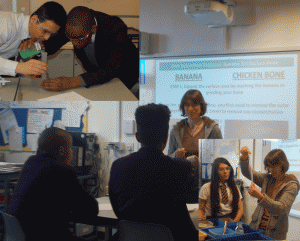
The genetic results were unsurprising: the CoLA chickens were pretty much identical to all other modern commercial chickens – there is worryingly little genetic diversity amongst ‘broilers’, as they have been selectively bred over the last 50 years to produce maximum amounts of meat in the minimum amount of time. This breeding programme has produced remarkable changes in the chicken skeleton, the young bones (broilers are ready for slaughter within 35 days of hatching) becoming warped by rapid growth and body weight. Learning about these anatomical changes, the CoLA students wondered if there might ever be a time when chickens were bred to be so big that they came to resemble the dinosaurs from which they descend…
Playing with this idea, Ben was inspired to undertake his most ambitious artwork project. With the help of the CoLA Art Club, Ben and his pupils worked tirelessly to study anatomical specimens of chickens and recreate them dino-size
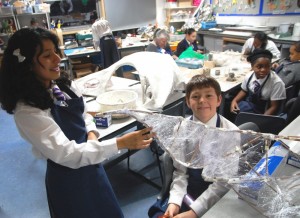
After many weeks and months of making, and considerable trauma working out how to articulate all the different giant bones, the majestic Dino-chicken was unveiled at the CoLA ‘Chicken Fest’ event in April where the pupils showcased all their works.
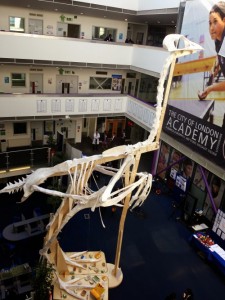
The CoLA Chicken Fest was made even more special as we were joined by dinosaur expert, Prof John Hutchinson, and palaeoartist, Luis Rey. They gave talks about how, through scientific investigation, it is possible to recreate the movement and appearance of dinosaurs, highlighting that they would have looked a lot more like chickens than we imagine, since most of them were feathery rather than scaly.
Hearing about the feathery appearance of dinosaurs was good news for the CoLA pupils because many of them had attended a day-school run by anthropologist and feather-artist, Rebecca Jewell. She had talked the group through her amazing artworks and inspired them to produce their own feather creations.
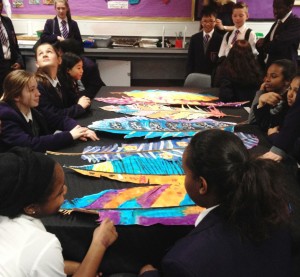
These were also on display at chickenfest, along with many other artworks produced by CoLA’s pupils: detailed studies of chicken breeds, ceramic pieces, DNA collages and still-life drawings of chicken carcasses, sketched on a school field-trip to a chicken processing factory.
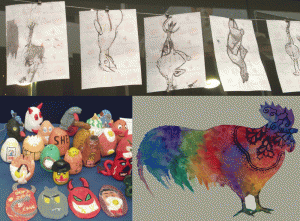
Reflecting on their trip to LOBO Meat & Poultry factory, year 8 CoLA pupils Kafayat Adesanya and Bill Worboyes said “it did not smell as bad as we thought but it was cold and eerie as we perched on plastic covered pallets in our plastic clothing to sketch the chickens”. Their English teacher, Ms Pitty, had asked the pupils to store up their feelings about the factory so that they could explore them in their creative writing classes. At Chicken Fest we were treated to readings of the poems that had been inspired by the factory trip: ‘The Proud Rooster’, ‘The Coward’, ‘Cruel?’, ‘Fares from Paris’, ‘Save the Chickens’ – just some of the powerful and uplifting works through which the pupils gave the chickens back an identity.
By being able to focus, in depth, on the subject of the chicken, the CoLA pupils have explored global history, food politics and have had the time to reflect critically on the ethics of their own consumption practices. The most eloquent expression of their feelings about the chicken’s descent from proud dinosaur to fast food was found at the feet of the ‘Chickenosaurus’, where gnarled chickens crafted from melted plastic-forks were seen hatching out from take-away boxes.
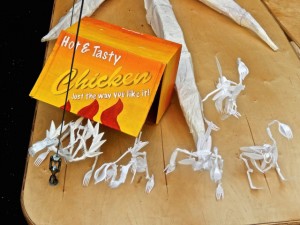
It is so clear how much the students, and staff, have learnt from their term of chicken studies. CoLA principle, Richard Bannister, said that “In all my 25 years of teaching I have never seen such an impressive and successful cross-curricular teaching programme, we are delighted to have been part of it”. Richard rounded off the chickenfest by inviting Ben onto the stage so that he could be presented with the Worshipful Co of Painters-Stainers Education Award, in recognition of his cross-curricular achievement. Members of the AHRC Chicken Project watched, like proud roosters, as Ben collected his much deserved award.
So what is next? The Chicken Project team will certainly continue to collaborate with CoLA and we have big plans to take the chickenosauraus on tour. Before that, we have decided to capitalize on the comedy value of the chicken. In November, as part of the ‘Being Human Festival’, we will be holding a stand-up comedy evening to satirize someof the core issues surrounding Being a Chicken in the 21st century. We already have America stand-up, Danny Lobell, flying in for the event. If you know of any stand-up comics who might like to do a set, tell them to get in touch! And stay tuned for further information.
Acknowledgements
Many thanks to Ben Frimet and all the staff and students at the City of London Academy for undertaking such great work on behalf of the chicken. The Scientific and Cultural Perceptions of Human-Chicken Interactions Project is funded by the Arts and Humanities Research Council. Find out more at www.scicultchickens.org or follow us on Twitter @Chicken_Project
Follow us
Keep up to date with the latest project news via our Twitter feed.
- — 5 years 8 months ago
- — 6 years 5 months ago
- — 6 years 6 months ago
- — 6 years 7 months ago

 ChickenCoop
ChickenCoop